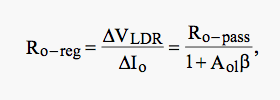tzg6sa
Member level 2
Hi All,
I have read the beginning of Ricon-Mora's PhD thesis, where I found the following statement by the AC analysis, what I do not understand.
"The output resistance of the load is commonly neglected because its value is considerably larger than Rx."
Where Rx = Ropass||'feedback divider'.
The pass transistor is a controlled current source, thus its output impedance is high. (At least few kohms) The feedback divider's resistance must be high to lower the quiescent current.
If I assume 1.8V output voltage and 6mA load current, then the load resistance is just 300ohm, which is not negligible at all. It would be negligible for a few uA load current.
Am I missing the obvious?
I have read the beginning of Ricon-Mora's PhD thesis, where I found the following statement by the AC analysis, what I do not understand.
"The output resistance of the load is commonly neglected because its value is considerably larger than Rx."
Where Rx = Ropass||'feedback divider'.
The pass transistor is a controlled current source, thus its output impedance is high. (At least few kohms) The feedback divider's resistance must be high to lower the quiescent current.
If I assume 1.8V output voltage and 6mA load current, then the load resistance is just 300ohm, which is not negligible at all. It would be negligible for a few uA load current.
Am I missing the obvious?
